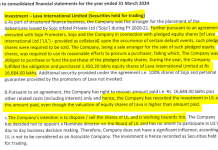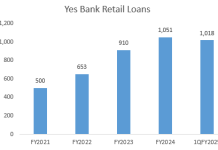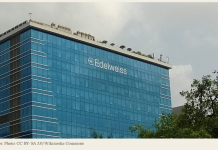Hemindra Hazari
Axis Bank is one of the favoured stars among the new private sector banks in India, with an enviable reputation. The Banker gave it the Bank of the Year award in 2014; Brand Equity termed it the “Most Trusted Private Sector Bank” two years in a row (2013, 2014); Asiamoney called it the “Best Domestic Bank in India” in 2014; and for three years in a row (2012-14), the Institute of Chartered Accountants of India honoured it for “Excellence in Financial Reporting” in the private sector banks category. (Source: Axis Bank Fiscal Year 2015 annual report.)
Thus it came as a surprise when Axis Bank, along with its results in the fourth quarter of the fiscal year (FY) 2016, also released a corporate lending watch list of standard loans of Rs 22,628 crore. To get an idea of the dimensions of the problem: the watch list constitutes 13% of corporate assets and a significant 45 % of equity capital. This disclosure was in addition to its net non-performing assets (NPA) of Rs 2,522 crore, restructured standard assets of Rs 8,072 crore, 5/25 scheme loans of Rs 3,740 crore and strategic debt restructuring of Rs 575 crore.
The term “watch list” is a bit misleading. It gives the impression that these loans need to be watched, but may eventually turn out be healthy. But Axis Bank stated 60% of the watch list will become non-performing assets (NPA) in the next eight quarters, with a bias towards the first half of the FY2017 (April-September 2016). Moreover, the security for these loans is woefully inadequate. Instead, the bank will have to provide 70% for these NPAs.
The capital market hailed the disclosure as a model of transparency with Jefferies, the global brokerage, in its report on Axis Bank’s asset quality dated April 26, 2016 saying, “You wanted clarity, now you have it !…with greater clarity comes visibility.” Bloomberg columnist, Andy Mukerjee added for good measure, “Shikha Sharma [CEO, Axis Bank] deserves a medal for honesty.” Before any medals for integrity, clarity and vision are bestowed, a thorough understanding of the timing of the release and the significance of the watch list is warranted as it raises important issues which need to be debated.
Timing of the release
While analysts have been estimating stressed loans of banks, Axis Bank had remained confident of its asset quality and even on its analyst conference call – held on January 20, 2016 for the third quarter of the FY2016 results, when banks had to incorporate additional stressed loans as a consequence of the Reserve Bank of India’s asset quality review (AQR) – the bank unequivocally stated that even though the Reserve Bank of India (RBI) had given two quarters to disclose and provide for the additional loans, Axis Bank had said “after going through this process of rigorous [RBI] testing [emphasis ours] of our portfolio, our asset quality metrics have come out higher than before with GNPA [Gross Non-Performing Asset] increasing from 1.38% in Q2 to 1.68% as on 31st December 2015 and Net NPA level increasing from 0.48% to 0.75%. During the quarter, fresh slippages into NPA stood at Rs 2,082 crore including the reclassifications proposed by the RBI, which comprised around half of the incremental slippages…as a prudent measure, …incorporated the full expected impact on the Bank in this quarter [3QFY2016] itself.”
Yet 91 days later, the bank disclosed a mammoth Rs 22,628 crore of stressed corporate standard loans, which it expects to become non-performing in a short period of time. Axis Bank has also remained silent and not provided any explanation on the timing of its release. The obvious question, which no one seems to ask, is what had changed in this period for such a large segment of corporate assets to become weak – had the economy gone into a sudden tailspin or had all efforts to hide a festering malignancy, deep in the bowels of the balance sheet, failed?
There was no major economic crisis in the world or the Indian economy to warrant a meltdown in corporate performance in the fourth quarter of the FY2016 for Axis Bank’s corporate asset book to significantly deteriorate. The needle of suspicion therefore points to lack of transparency which analysts had long spoken in hushed whispers, but few had been bold to publicise.
CEO tenure and growing profits
In the absence of cataclysmic events, weak assets – constituting 13% of the corporate book, 6% of total customer assets and more importantly 45% of equity capital – cannot suddenly surface in the span of 91 days. There have been many concerns on corporate loans and banks ballooning infrastructure assets set up at inflated costs and incomplete, but nearly fully funded, capital projects. Government banks had been reporting poor results since FY2014 but new private sector banks like Axis Bank – which had significant corporate and infrastructure assets – had been defying the trend by consistently reporting growth in profits till the third quarter of the FY2016. However, despite all efforts banks cannot indefinitely defy reporting deteriorating asset quality and judgement day has to dawn.
Long serving CEOs (for example Shikha Sharma was appointed Axis Bank CEO since June 2009 and has been adequately rewarded in compensation) try to keep reporting consistent rise in profits as it increases the share price and more importantly justifies huge remuneration in the form of salary, bonus and stock options. In such an environment, CEOs are reluctant to report either a decline in profits or profits which are unable to meet consensus analyst forecasts. Indeed Axis Bank’s FY2015 annual report had nothing but praise for its CEO and the board of directors justifying her re-appointment for a further three years from June 1, 2015 . “The Bank has in the three years of her current [2012-2015] tenure, been able to consistently deliver profitability as well as returns to its shareholders under her leadership in the challenging economic and macro environment. The NPAs and restructured assets have been kept in control, with strong focus on guardrails [emphasis ours],” it said. In the light of the watch list disclosure, where slightly less than half of the bank’s capital stands exposed, one wonders how the board did not question the numbers in the face of a challenging environment.
In government banks, as the tenure of CEOs is short, new CEOs tend to periodically clean up the bank and blame it on their predecessor but this is not an option for long serving new private sector banks CEOs. Globally, when major problems surface in banks, the entire senior management is rightfully removed as markets demand accountability. But in ICICI Bank (which also reported significant weak assets) and Axis Bank, the only deemed punishment is no bonus or a cut in variable pay for the senior management. In India, the regulator, the media and the analysts, who all praise the workings of the free market, do not seem to insist on implementing its key tenet: accountability.
Relevance of RBI’s asset quality review
The RBI’s asset quality review (AQR) was to have brought transparency to the Indian banking industry and expose the hidden NPAs in the system. But in the case of Axis Bank it failed miserably. In the third quarter of the FY2016, the AQR after “rigorous [RBI] testing” resulted in additional NPAs of around Rs 2,800 crore (inclusive of sale of Rs 1,800 crore power sector loan to an asset reconstruction company in 2QFY2016). Ninety-one days later, Axis Bank informs the public that its watch list of Rs 22,628 crore is eight times the size of RBI’s AQR. How did the watch list escape the notice of RBI inspectors? The RBI’s oversight in Axis Bank’s case has major ramifications for the industry on the credibility of the AQR in revealing the true asset quality of Indian banks.
Negligible credit Expertise in Board of Directors
There is a perception in the market, of the quality of the board of directors being superior in new private sector banks as compared with the government banks. Boards of new private sector banks are filled with luminaries from academia, the corporate world and former senior government bureaucrats. Such individuals are supposed to be more effective in supervising management and protecting minority shareholders. The Axis Bank board of directors has its share of luminaries, with a retired Indian administrative service officer as its non-executive chairman, eminent individuals from the financial market, technology, chemicals and power industries, and academics as its non-executive directors. But a closer inspection of its board of directors reveals a strategic weakness which could explain why the bank’s poor corporate asset quality took some time to be publicly revealed.
The Axis Bank board of directors consists of 15 individuals: four executive directors (including the CEO), two nominee directors representing the interests of Special Undertaking of Unit Trust of India (SUUTI) and Life Insurance Corporation and nine independent directors (including the chairman). The background of the executive directors is revealing. Sharma, prior to being appointed as the bank’s CEO in June 2009, was associated with ICICI in its life insurance, retail and investment banking divisions and early in her career had exposure to project finance. V. Srinivasan, deputy managing director, joined Axis Bank in 2009 and has a background in treasury, investment banking, capital markets and foreign exchange management. Rajiv Anand, in charge of retail banking, has a background in treasury and asset management. Finally, Rajesh Dahiya’s expertise is in human resources and administration.
Even though credit risk assets at Rs 3,45,867 crore constitutes 84% of Axis Bank’s total risk weighted assets and corporate credit at Rs 1,55,384 crore is the largest component (46%) of total credit in FY2016, none of the executive directors of this large and prominent Indian private sector bank have strong credit management expertise in appraising and monitoring corporate and small and medium enterprise credit.
Debt and treasury management expertise has far less weightage as they deal in highly rated (‘AAA’, ‘AA’) corporate paper, which does not require much credit appraisal and credit monitoring skills. The nominee directors are career cadre officers of their parent companies and have expertise in asset management and life insurance. The non-executive independent directors with the exception of S. Vishvanathan (ex State Bank of India) and Samir K. Barua (academic and former director, IIM, Ahmedabad) do not have a history associated with credit management. Hence in a board of 15 directors there are only two independent directors who can comprehend the intricacies of credit risk management.
The board of directors in an Indian bank (where credit is the major risk) must have a sizeable number of non-executive directors who have a background in credit and risk management – and who can grill bank executives in credit appraisal and credit monitoring – especially at Axis Bank where even the executive directors lack the required credit management skills. This is all the more important when there is a well established CEO who would like to report a consistent rise in profits for the bank even when the economy is experiencing problems. Given what we now know, Axis Bank’s 21% growth in annual net profits from FY2012 till FY2015 was unwarranted and its board of directors should have exercised greater caution on why the bank was reporting significantly lower non-performing loans and higher profits when government banks having a similar corporate and infrastructure portfolio were reporting higher NPAs and lower profits.
Myth of excessive loan security and early exit
Axis Bank’s watch list also exposes another myth associated with new private sector banks – they are insulated from the corporate slowdown as compared to government banks since they are prudent about demanding more security from stressed corporate borrowers and because they are able to exit such accounts at an early stage. An interesting but unappreciated feature of Axis Bank’s watch list is that only 27.5 % (Rs 6,226 crore) of it is restructured and in strategic debt restructuring while 72.5% (Rs 16,402 crore) is non-restructured, standard asset.
The issue is that the bank sees that Rs 13,577 crore of standard loans is going to be NPA in a short time; so why has it been unable to exit these standard accounts by selling these loans at a discount in the market? The bank has also maintained that it will provide 70% for these soon to be bad loans which also raises another issue that they have security of only 30% for these loans. These two issues completely overturn the widely held view that new private sector banks are able to demand extra security for loans and are able to exit early when problems are detected. The simple truth is that for the watch list standard loans there is no market and it has negligible security because they have been poor quality loans for a long time.
When a bank sees that a large component of credit is going to become non-performing and there is negligible security and no exit, prudence dictates that the board of directors instructs the bank to start reporting lower profits by building up its contingency reserve at an early stage so as not to disrupt capital and future earnings. In the FY2015, not only was Axis Bank’s contingency provision inadequate at Rs 1,200 crore but by the FY2016 it was reduced to Rs 400 crore – the balance sheet of a prominent new private sector bank has been left virtually defenceless to face the onslaught of the watch list.
The bank states in its watch list presentation that “the process of creating the list was driven by the bank’s Risk Management led by CRO [Chief Risk Officer]”. In Axis Bank’s case it appears that either the risk division like Kumbhakarna of Ramayana fame was in deep slumber when corporate assets were rapidly falling in value; or, more likely, it was sounding the alarm, but the board of directors with their limited understanding of credit did not comprehend its gravity, and the board was unwilling to challenge a well-entrenched CEO who did not want to disrupt the annual growth in profits. Whatever the reason, it has finally culminated in exposing 45% of the bank’s precious capital to corporate credit risk.
Significant impact on future earning
In FY2016, Axis Bank reported net profit of Rs 8,224 crore (nearly 12% growth over FY2015), in the next two years (FY2017 and FY2018) the bank will have to annually provide for Rs 4,750 crore for bad debts and not accrue interest (assuming 12%) of around Rs 814 crore aggregating to Rs 5,564 crore on its watch list exposure. The smooth net profit growth of the past is going to get majorly disrupted in the immediate future and although the bank states that this is the extent of its corporate loan problem and analysts to justify their “buy” recommendation are forecasting a revival in profits from FY2018, problems could emerge from the bank’s retail, small business and agricultural portfolio in the future.
Post the announcement of its watch list, analysts and commentators rushed to praise Axis Bank for its transparency without doing a deeper probe of the bank’s early warning systems – the guardrails intended to protect the sliver of equity propping up the twin mountains of liquid deposits and ill-liquid credit. These commentators proved to be no better than those institutions who grant annual awards which the bank dutifully publishes to its shareholders and the bank’s board of directors who spoke eloquently on the robustness of the ring fencing but which proved illusionary.
















One of the excellent analysis on inadequacies of the management of private sector banks, busting a lot of long held myths about the same. In this connection,I would like to hear from you on Indusind bank & HDFC bank where the CEO terms are due to end shortly. As a layman, we are highly concerned and perplexed why Indusind bank is delaying it 4Q 2019 & the yearly results when it is known as the first bank & almost the first major company in India to declare its quarterly results with aplomb.The point regarding change in CEO coming out with huge write off/NPA’s has been once again proven in case of Yes bank recently. Now as ordinary investors we are highly concerned and under suspense for what to expect when the CEO’s change in Indusind and HDFC bank.In the last five years a lot of investors have shifted their investments from PSU’S to new generation private sector banks after burning a lot of hard earned and tax paid money in PSU banks with the premise that they have the virtues of much superior returns. Is that premise now at stake ?